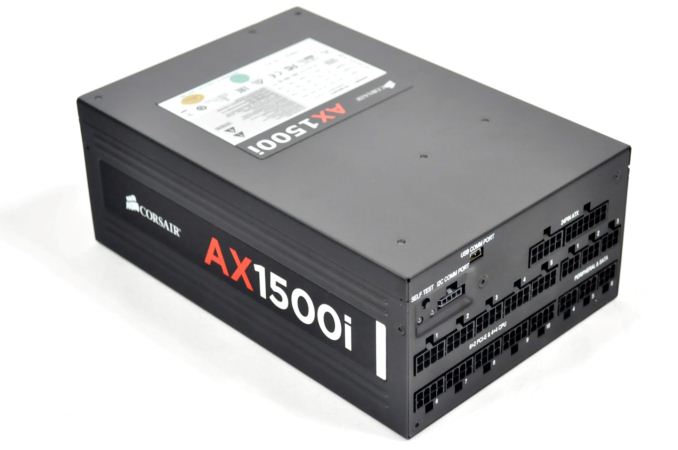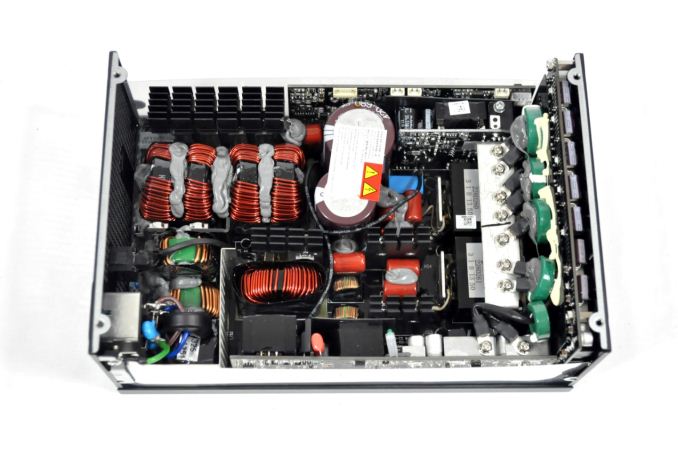Corsair AX1500i Power Supply Review
by E. Fylladitakis on September 11, 2014 5:00 AM EST- Posted in
- Cases/Cooling/PSUs
- Corsair
- PSUs
- 1500W
Conclusion
The AX1500i is definitely a special kind of product. It aims not for a particular group of users, but for the cream of hardcore overclockers, enthusiasts, gamers, and professionals. In other words, it targets users that both have crazy power requirements and, at the same time, require excellent overall performance. Of course, if you do not possess a very power-hungry system with multiple high end GPUs and CPUs, the massive output of the AX1500i would not make any sense to begin with.
Both externally and internally, the AX1500i has been very carefully designed and built. It is aesthetically appealing without being extravagant and the fully modular design is appreciable on a unit with so many cables. Only the size of the chassis could become a problem in smaller cases but we can hardly imagine someone purchasing a $450 PSU with the purpose of installing it inside a run of the mill case. Inside the AX1500i, Corsair uses fine quality components and has one of the most detailed assembly jobs ever performed. They really cut no corners when designing and building this power supply.
When it comes to performance, the Corsair AX1500i is almost frightening. Starting with the efficiency, as the 80 Plus Titanium certification is one of the primary selling points of this product, the AX1500i has a higher average efficiency than the top efficiency many 80 Plus Platinum units can achieve. It also has exceptionally high efficiency at low loads, which is very useful for a unit of this output, as the power requirements of even the most power hungry systems while idling are just a few percent of this unit's capacity. The quality of the output is also breathtaking, with very low voltage ripple even under massive loads and unparalleled regulation. Furthermore, due to the high efficiency, the AX1500i emits only very low volumes of heat, allowing it to operate virtually fanless across a large portion of its capacity range. The Corsair AX1500i undoubtedly delivers the best all-around performance that we have seen to this date.
With the release of the AX1500i, to our eyes, Corsair has simply tried to create the very best power supply possible, regardless of the cost and market potential. They did succeed on breaking almost every performance record we can come up with for a consumer-grade PSU... but that includes the record for being the most expensive unit a consumer can currently buy.
With a retail price of $450, this is definitely not a product aiming for the masses. Using any 1500W PSU to power even a high-end gaming PC, let alone a basic Home/Office PC, would be the very definition of the word "overkill". Corsair's AX1500i is a PSU meant for the most advanced gaming computers and workstations, and only for those users that are willing to spend a few hundred extra bucks in order to get the very best there is.
It's doubtful most of us will ever use such a product, but just as the 80 Plus program brought higher efficiency power supplies to the masses, products like the AX1500i will inevitably have a "trickle down" effect. Seven years ago the cost of a good 80 Plus Bronze 1000W PSU ranged from around $250 to over $300. Such power supplies were mostly overkill even then, but today you can find them for less than half the price, and higher efficiency 80 Plus Gold PSUs aren't much more. It may take some time to get there, but undoubtedly we will see much of the technology in the AX1500i makes it's way into more reasonable products. You have to start somewhere, and R&D often starts at the top.












55 Comments
View All Comments
CrazyElf - Thursday, September 11, 2014 - link
It will mostly be of use for people who are using quadruple GPU configurations or highly overclocked triple GPU configurations.But yes, as the article notes, it's a niche product and arguably an overpriced product for what it offers. We'll see what similar 1500-1600W PSUs offer by other manufacturers in the coming months.
Vatharian - Thursday, September 11, 2014 - link
Good, you mentioned, almost. I've build recently dual cpu (using Supermicro X9DRG-QF), 5 GPU (Titan black) workstation, water cooled (for sake of efficiency and longevity, not wow factor), and it refused to boot on Corsair AX1200i, switched to dual Seasonic X1250, and it peaks around 2.1kW from wall (on 230V).piroroadkill - Thursday, September 11, 2014 - link
Holy shit. Now that's baller.mapesdhs - Thursday, September 11, 2014 - link
And I thought my quad-580 3930K was nuts. :DCool dude!!
Ian.
Chrispy_ - Monday, September 15, 2014 - link
Assuming you're running an SSI EEB board, you should really be using server-grade EPS supplies rather than this consumer junk. Drawing 2.1kW from the wall is all the evidence you should need for this! ;)Barilla - Thursday, September 11, 2014 - link
80+ and 80+ titanium are two different things. And there are actually some people that need this kind of power, although not many.Sabresiberian - Thursday, September 11, 2014 - link
You know what is really useless? Comments about how a product is useless.They do more to show how limited the imaginations of the authors (of such comments) are than anything else.
petteyg359 - Sunday, February 15, 2015 - link
Just because you don't give a crap about efficiency doesn't mean others won't. Going from 84% to 92% efficiency on a 500W load is over 1.2 kWh saved every day. At $0.15 per KWh, the PSU will more than pay for itself within the warranty period.Pissedoffyouth - Thursday, September 11, 2014 - link
As a 220v user (New Zealand), due to higher efficiency should we also see lower temperatures?DanNeely - Thursday, September 11, 2014 - link
Slightly. 220v is generally 1-2% more efficient than 110; meaning at full load you'd have 15-30W lower losses being converted into heat.